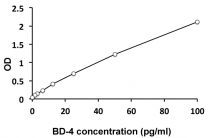ARG80902
Human BD-4 / beta Defensin-4 ELISA kit
Human BD-4 / beta Defensin-4 ELISA kit for ELISA and Human
Immune System kit; Microbiology and Infectious Disease kit
Overview
| Product Description | ARG80902 Human BD-4 / beta Defensin-4 ELISA kit is a Enzyme Immunoassay kit for the quantification of Human BD-4 / beta Defensin-4 in Serum, Plasma, Cell culture supernatants |
|---|---|
| Tested Reactivity | Hu |
| Tested Application | ELISA |
| Specificity | No significant cross-reactivity or interference with BD-1 (36 aa), BD-1 (47 aa), BD-2, BD-3. |
| Target Name | BD4 / beta Defensin 4 |
| Conjugation | HRP |
| Conjugation Note | Substrate: TMB and read at 450 nm |
| Sensitivity | 0.8 pg/ml |
| Sample Type | Serum, Plasma, Cell culture supernatants |
| Standard Range | 1.56 - 100 pg/ml |
| Sample Volume | 100 µl |
| Precision | CV: less than10% |
| Alternate Names | DEFB-4; hBD-4; Defensin, beta 104; Beta-defensin 104; DEFB4; BD-4; Beta-defensin 4; DEFB104 |
Application Instructions
| Assay Time | 4 hours |
|---|
Properties
| Form | 96 well |
|---|---|
| Storage Instruction | Store the kit at 2-8°C. Keep microplate wells sealed in a dry bag with desiccants. Do not expose test reagents to heat, sun or strong light during storage and usage. Please refer to the product user manual for detail temperatures of the components. |
| Note | For laboratory research only, not for drug, diagnostic or other use. |
Bioinformation
| Database Links | |
|---|---|
| Gene Symbol | DEFB104A |
| Gene Full Name | defensin, beta 104A |
| Background | Defensins are 2-6 kDa, cationic, microbicidal peptides active against many Gram-negative and Gram-positive bacteria, fungi, and enveloped viruses [PMID: 8528769], containing three pairs of intramolecular disulphide bonds. On the basis of their size and pattern of disulphide bonding, mammalian defensins are classified into alpha, beta and theta categories. Every mammalian species explored thus far has beta-defensins. In cows, as many as 13 beta-defensins exist in neutrophils. However, in other species, beta-defensins are more often produced by epithelial cells lining various organs (e.g. the epidermis, bronchial tree and genitourinary tract). Defensins are produced constitutively and/or in response to microbial products or proinflammatory cytokines. Some defensins are also called corticostatins (CS) because they inhibit corticotropin-stimulated corticosteroid production. The mechanism(s) by which microorganisms are killed and/or inactivated by defensins is not understood completely. However, it is generally believed that killing is a consequence of disruption of the microbial membrane. The polar topology of defensins, with spatially separated charged and hydrophobic regions, allows them to insert themselves into the phospholipid membranes so that their hydrophobic regions are buried within the lipid membrane interior and their charged (mostly cationic) regions interact with anionic phospholipid head groups and water. Subsequently, some defensins can aggregate to form `channel-like' pores; others might bind to and cover the microbial membrane in a `carpet-like' manner. The net outcome is the disruption of membrane integrity and function, which ultimately leads to the lysis of microorganisms. Some defensins are synthesised as propeptides which may be relevant to this process. [provide by Interpro: IPR006080] |
| Function | Has antimicrobial activity. Synergistic effects with lysozyme and DEFB103. [UniProt] |
| Highlight | Related products: beta Defensin4 antibodies; beta Defensin4 ELISA Kits; Related news: New MMP7 (total or active) ELISA kits are released New ELISA data calculation tool: Simplify the ELISA analysis by GainData |
| Research Area | Immune System kit; Microbiology and Infectious Disease kit |
Images (1) Click the Picture to Zoom In
| Title | Download Link |
|---|---|
| ARG80902 Human BD-4 / beta Defensin-4 ELISA kit User Manual |
 Download Download
|






